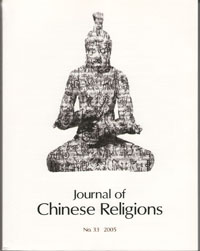2.2 Flesh Bodies, Stiff Corpses, and Gathered Gold (2006)
For Taiwanese, manes (souls of the dead) can be categorized into three rough categories: gods, ghosts, and ancestors. There are also intermediate categories between these three. Different kinds of bodily remains correspond to the different categories of manes that inhabit them. People can change the status of manes (a ghost becoming a god, for instance) through ritual action, which includes physical manipulation of bodily remains by processes such as mummification or destruction of the flesh. Beliefs motivating such practices are widely distributed though different religious communities and social classes. Mummification of the special dead, for instance, has been practiced in groups ranging from elite, Buddhist monastic communities to small, local spirit-medium cults.
Reference: Gildow, Douglas Matthew. 2005. “Flesh Bodies, Stiff Corpses, and Gathered Gold: Mummy Worship, Corpse Processing, and Mortuary Ritual in Contemporary Taiwan.” Journal of Chinese Religions 33. [This journal was actually published in spring 2006.]
Related Links:
- Download the full article.
- My webpage 2.3, on a related article on Taiwanese Buddhist mummies.
- National Geographic film clip on second burial in Taiwan.
- Download the Taiwanese typeface, the Taigi Unicode TrueType font, designed by 劉杰岳, from this website.
- My webpage 3.4, a partial translation of a Japanese article on Chinese Buddhist mummies.
- My webpage 5.1, a photo album of Asian mummies.
- My webpage 5.3, a photo album on exhumation and second burial in Taiwan.
- National Geographic 2009 article on mummies in Sicily.
|
|
 |
| |
| |
Outline
2.2.1 Errata
2.2.2 Suggestions and Comments
2.2.1 Errata
Page |
Mistaken Text
|
Corrected Tex |
| 7 |
Note 17, Line 3: “Chinese,; and” |
“Chinese; and” |
2.2.2 Suggestions and Comments
Page
|
Original Text
|
Suggested Change or Comment |
| 1 |
Unnumbered footnote, on romanization system for Taiwanese. |
In retrospect, I now advocate use of POJ (also called “Church Romanization”) for all Taiwanese (and for all Southern Min, for that matter). This system has been around for almost 150 years and the great majority of writings in romanized Taiwanese use this system. So does the Bân-lâm-gú 閩南語 version of Wikipedia. |
2
|
Para. 1, Line 3: “while writing this previous” |
“while writing that previous”
|
3
|
P 2, L 5: “golden bodies”
|
In Taiwanese, kim-sin 金身 often signifies a statue of a deity, regardless of its color or material. Even black or brown wooden statues can be called kim-sin. Kim 金 as an adjective can signify “precious” (ex.: kim-kiáⁿ 金囝, “beloved son”) or “related to worship or funerals” (ex.: kim 金, “ancestral bones”). I once heard discussion in an art history class about whether 金像 should be translated “golden images,” “gilded images,” or “metal images.” In texts originating from some linguistic communities, perhaps it could simply be translated “precious or sacred images.”
In a film I saw on the production of icons for popular religion (National Museum of Science, Taichung, Taiwan, 29 December 2006), one traditional statue carver indicated that the five colors (blue/green, white, red, black, yellow/gold) are used in statues, and that these colors correspond to the five directions (east/west/south/north/center). As a color, gold 金 can stand for yellow, and yellow is the “central” color and hence the most important color. The statue carver then suggested that religious statues are called 金身 because (1) all such statues should have gold foil added to part of them, and (2) gold (yellow) is the most central/important color. In fact, though, not all religious statues contain gold foil. And confusingly, as an element, metal 金 is not the central element. For correspondences in traditional Chinese thought between colors, directions, elements, and other phenomena, see JordanFiveElements. |
5
|
N. 12, “For mention of retreats…”
|
(I could find a better reference for spirit-medium retreats than that.) |
6
|
N. 13 |
Here I adapt a definition of Buddhism that reflects the biases of Buddhist monastics and modern scholars. For discussion of other forms of “Buddhism,” see webpage 1.2.3, “Comments on the Ritual Masters.” |
10
|
P 1, on Shi Kaifeng
|
By today (Sept. 2008), Shi Kaifeng’s body has already been preserved as a mummy. See the relevant Kaifeng YouTube video as well as a website with related photographs. |
13
|
Last line, “The most recent…”
|
This line would look much better if moved to the first line of page 14. |
| 22 |
P 1, L 3: “translating yangshidi” |
The original French article glosses the translation with yang che ti. Translating from the French EFEO romanization system into Hanyu Pinyin, we get yangshidi. |
23
|
P 3: “cutting” ritual
|
See a version of this ritual on webpage 1.2.2, “String-Cutting and Coffin Sealing.” |
25
|
N. 75, on jiangshi
|
For a music video/running advertisement for Motorola Inc. featuring jiangshi, including cute little jiangshi like those mentioned this article, see Taiwanese singer Jay Chou’s 周杰倫 music video, “Bencao gangmu” 本草剛目. |
30
|
P 2, L 1: “than just politically ignoring” |
“than diplomatically ignoring”
|
| 32 |
P 1, L 1: “when they are” |
“they are” |
Back to Top
|
|

